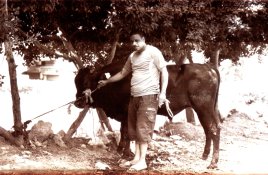In case anyone is wondering, this was copied from Ryuji Suzuki's web site some years ago:
Polysulfide toning
Polysulfide toners provide direct toning to give darker brownish hue compared to sepia toners. This toning also releases hydrogen sulfide gas, with its characteristic rotten egg odor. This gas is toxic at a higher concentration. Therefore, this toning must be performed in well ventilated area.
Off shelf products include: Kodak Brown Toner (KBT), AGFA Viradon (new version)
T-8 polysulfide brown toner
potassium polysulfide 7.5g
sodium carbonate 2.4g
water to make 1 liter
Relatively brief toning is adequate for image protection, but toning to obrain brown hue may take several minutes with neutral toned paper. This can be accelerated by warming the toning bath. The actual temperature should be tested with test prints to ensure lack of emulsion damage, but should not exceed 40°C.
In order to prevent staining and halt toning immediately, use of a sulfite "stop bath" is highly recommended (almost obligatory for succssful toning). Prepare a tray containing 20g or more of sodium sulfite anhydrous in a liter of water. Toned prints are immediately transferred in to this "stop bath" tray. After a few good agitaion, the print can be sent to rinse and final wash processes. Without this step, the margins and highlight areas may exhibit pink or yellow staining, reducing the paper base's brilliance.
Similarly, a toning bath that is weaker than recommended strength or a bath that is exhausted runs similar risk of staining the print base.
Prints treated with this type of toner are well protected against oxidative attacks.






